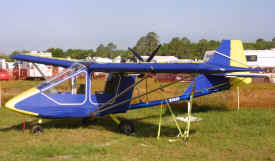The CGS Hawk was first introduced at Sun N Fun in 1982 winning Best New
Design for 1982, and Outstanding New Design and Reserve Grand Champion
at Airventure. It is amazing to find that the old girl still has the
ability to turn judges eyes some 26 years later winning Reserve Grand Ch ampion
this year at Sun N Fun! ampion
this year at Sun N Fun!I have done a number of interviews with Chuck
Slusarczyk over the years. He is someone that I feel has a pulse on the
industry.
In talking to Chuck over the last couple of years he has indicated
that he would not likely be entering the Light Sport Aircraft market,
but would continue to offer legal part 103 ultralights and
experimental/amateur built kits.
So when I heard through the rumour mill that he was about to offer
his two place Hawk as a Light Sport Aircraft I popped over to his booth
to get the story. While Chuck's view that those that pushed through the
light sport category, at the expense of a vibrant ultralight and
ultralight training market, made a serious mistake - has not changed.
His business side has identified that he has an opportunity. Chuck
originally got into ultralight aviation because of the run-a-way costs
involved in conventional aviation. That was over 30 years ago! He now
sees the same thing happening again with the light sport category. With
most of the light sport coming in from $80,000 to over 100,000 he feels
that their "might be a niche" for the Hawk.
To supply the Light Sport Aircraft market with something that it is
sorely missing. An affordable two place factory built, ready to fly
light sport aircraft or 2 place trainer that sells for under $50,000!
According to Chuck "when they took away our two place training waiver
they set us back 20 years!" "The question 20 years ago was how do you
train someone how to fly a single place ultralight?" "the two place
waiver worked very successfully, training 10's of thousands of pilots."
"When lightsport was being first being talked about I understood that
they would, take what needed fixing in our end, and introduce a new
category for light sport."
"Instead they used the atomic bomb approach to kill a fly." According
to Chuck this really hurt the lower end of the aviation market place.
Not all pilots want to fly along at 100 mph, and most "mom and pop
operations, operating from their grass strips, training 5 or 6 students
a year can't afford to own and operate aircraft as trainers under the
new light sport category rules."
Before light sport they could buy a kit, assemble and maintain it
themselves. Thus keeping the cost to a minimum. A small operation might
train only 5 or 6 students a year, but when you have 300 - 400 of these
across the country you end up with a real grass roots affordable
training environment that was training ULTRALIGHT pilots how to fly.
"Instead they have gutted a whole industry." From the pilots
associations that built up the very successful two place training
program. To ultralight aircraft and engine repair stations, and
suppliers of helmets, intercoms who supplied that industry. They have
all been hurt by the loss of the training waiver.
So why is CGS now entering the LSA market place? To fill two niche
markets. The first is a two place trainer that looks, feels, and flies
like an ultralight. The second an affordable two place aircraft that a
pilot can afford to own and fly.
Chuck indicates his single place ultralight aircraft in kit form in
2008 dollars sells for about $12,000. The two place Hawk is available as
an amateur/homebuilt, as an ELSA, and finally as a factory built, ready
to fly SLSA.
All of the paperwork has been completed and the Hawk is about to
enter the flight testing stage of the LSA program.
Once the Hawk is approved Chuck is looking at setting up a number of
satellite shops across the country to build and do maintenance work on
the Hawks. So if you are an investor looking at getting into the
ultralight and light sport aircraft market, with a tried and tested
manufacture and product give Chuck a call.
CGS AVIATION
P.O. BOX 470635
BROADVIEW HEIGHTS, OH 44147
USA
440-564-1214
www.cgsaviation.com
Editors Note:
If you look at the lightsport aircraft market few if any of the NEW
light sport aircraft manufacturers are offering a single place aircraft.
Ad to that the craft they are offering do not look feel or fly like a
single place ultralight.
In Canada we have a population of 30,000,000 people with some 6,000
aircraft on the registry.
In the U.S. you have a population of 300,000,000 people which would
mean that at the time light sport was introduced you should have had in
the area of 60,000 ultralight style aircraft flying.
LESS than 5,000 aircraft were put through under the exemption! What
happened to the thousands of other aircraft? If these had been Warbirds
or Antique Aircraft I will guarantee you that someone would have come
forward to protect them! |


